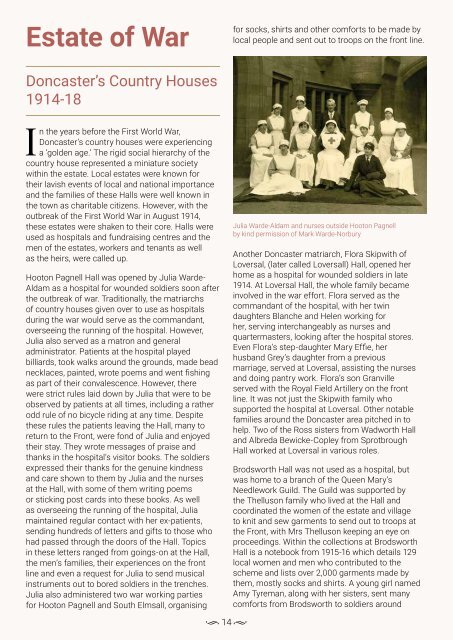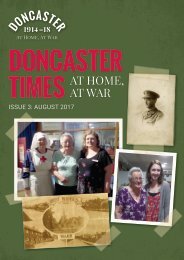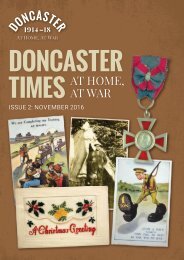Doncaster Times Issue 1 - June 2016
Doncaster Times is a biannual publication of articles and pieces researched and written by members of the public, volunteers and professionals. For its first four years, the magazine will feature articles about Doncaster during the First World War, to commemorate the centenary. The most recent publication is available in hard copy only, available to purchase from Doncaster Museum and Art Gallery, Doncaster Central Library and the Tourist Information Centre.
Doncaster Times is a biannual publication of articles and pieces researched and written by members of the public, volunteers and professionals. For its first four years, the magazine will feature articles about Doncaster during the First World War, to commemorate the centenary. The most recent publication is available in hard copy only, available to purchase from Doncaster Museum and Art Gallery, Doncaster Central Library and the Tourist Information Centre.
Create successful ePaper yourself
Turn your PDF publications into a flip-book with our unique Google optimized e-Paper software.
Estate of War<br />
for socks, shirts and other comforts to be made by<br />
local people and sent out to troops on the front line.<br />
<strong>Doncaster</strong>’s Country Houses<br />
1914-18<br />
In the years before the First World War,<br />
<strong>Doncaster</strong>’s country houses were experiencing<br />
a ‘golden age.’ The rigid social hierarchy of the<br />
country house represented a miniature society<br />
within the estate. Local estates were known for<br />
their lavish events of local and national importance<br />
and the families of these Halls were well known in<br />
the town as charitable citizens. However, with the<br />
outbreak of the First World War in August 1914,<br />
these estates were shaken to their core. Halls were<br />
used as hospitals and fundraising centres and the<br />
men of the estates, workers and tenants as well<br />
as the heirs, were called up.<br />
Hooton Pagnell Hall was opened by Julia Warde-<br />
Aldam as a hospital for wounded soldiers soon after<br />
the outbreak of war. Traditionally, the matriarchs<br />
of country houses given over to use as hospitals<br />
during the war would serve as the commandant,<br />
overseeing the running of the hospital. However,<br />
Julia also served as a matron and general<br />
administrator. Patients at the hospital played<br />
billiards, took walks around the grounds, made bead<br />
necklaces, painted, wrote poems and went fishing<br />
as part of their convalescence. However, there<br />
were strict rules laid down by Julia that were to be<br />
observed by patients at all times, including a rather<br />
odd rule of no bicycle riding at any time. Despite<br />
these rules the patients leaving the Hall, many to<br />
return to the Front, were fond of Julia and enjoyed<br />
their stay. They wrote messages of praise and<br />
thanks in the hospital’s visitor books. The soldiers<br />
expressed their thanks for the genuine kindness<br />
and care shown to them by Julia and the nurses<br />
at the Hall, with some of them writing poems<br />
or sticking post cards into these books. As well<br />
as overseeing the running of the hospital, Julia<br />
maintained regular contact with her ex-patients,<br />
sending hundreds of letters and gifts to those who<br />
had passed through the doors of the Hall. Topics<br />
in these letters ranged from goings-on at the Hall,<br />
the men’s families, their experiences on the front<br />
line and even a request for Julia to send musical<br />
instruments out to bored soldiers in the trenches.<br />
Julia also administered two war working parties<br />
for Hooton Pagnell and South Elmsall, organising<br />
Julia Warde-Aldam and nurses outside Hooton Pagnell<br />
by kind permission of Mark Warde-Norbury<br />
Another <strong>Doncaster</strong> matriarch, Flora Skipwith of<br />
Loversal, (later called Loversall) Hall, opened her<br />
home as a hospital for wounded soldiers in late<br />
1914. At Loversal Hall, the whole family became<br />
involved in the war effort. Flora served as the<br />
commandant of the hospital, with her twin<br />
daughters Blanche and Helen working for<br />
her, serving interchangeably as nurses and<br />
quartermasters, looking after the hospital stores.<br />
Even Flora’s step-daughter Mary Effie, her<br />
husband Grey’s daughter from a previous<br />
marriage, served at Loversal, assisting the nurses<br />
and doing pantry work. Flora’s son Granville<br />
served with the Royal Field Artillery on the front<br />
line. It was not just the Skipwith family who<br />
supported the hospital at Loversal. Other notable<br />
families around the <strong>Doncaster</strong> area pitched in to<br />
help. Two of the Ross sisters from Wadworth Hall<br />
and Albreda Bewicke-Copley from Sprotbrough<br />
Hall worked at Loversal in various roles.<br />
Brodsworth Hall was not used as a hospital, but<br />
was home to a branch of the Queen Mary’s<br />
Needlework Guild. The Guild was supported by<br />
the Thelluson family who lived at the Hall and<br />
coordinated the women of the estate and village<br />
to knit and sew garments to send out to troops at<br />
the Front, with Mrs Thelluson keeping an eye on<br />
proceedings. Within the collections at Brodsworth<br />
Hall is a notebook from 1915-16 which details 129<br />
local women and men who contributed to the<br />
scheme and lists over 2,000 garments made by<br />
them, mostly socks and shirts. A young girl named<br />
Amy Tyreman, along with her sisters, sent many<br />
comforts from Brodsworth to soldiers around<br />
•<br />
14 •




